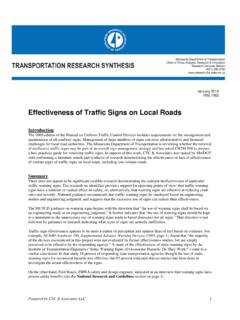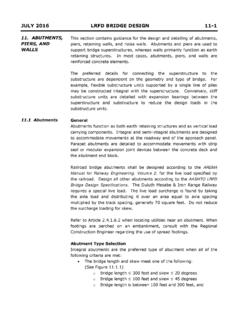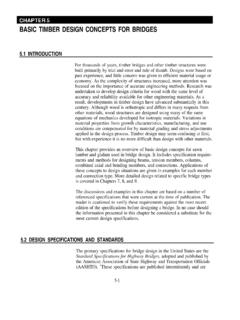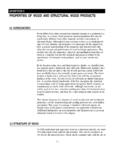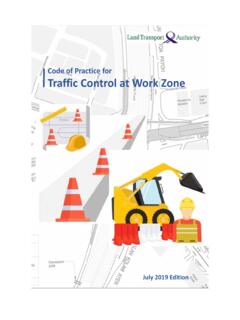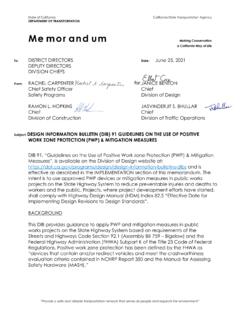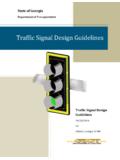Transcription of MnDOT Pavement Marking Field Guide
1 MnDOT Pavement Marking Field GuideMnDOT Pavement Marking Field GuideJune 2015 Office of traffic , Safety, and TechnologyContacts: Michelle MoserPavement Marking & traffic Devices EngineerOffice of traffic , Safety, and Technology651-234-7380 E. JohnsonWork Zone, Pavement Marking , & traffic Devices EngineerOffice of traffic , Safety, and Technology651-234-7386 Jeff MoreyPavement Marking & traffic Devices SpecialistOffice of traffic , Safety, and Technology651-234-7373 DanielState Epoxy Striping Supervisor320-223-6564 LindblomState Latex Striping Supervisor651-366-4371 Marking Field Guide June 2015 Page iTable of ContentsSection A.
2 Introduction A-1 Section B: Glossary B-1 Section C: Standard Practices C-1 Section D: Retroreflectivity D-1 Figure D-1: Roadway with Unbeaded Markings D-1 Figure D-2: Roadway with Beaded Markings D-1 Section E: Retroreflective Glass Beads E-1 Figure E-1: How Beads Reflect Light Back to Source E-1 Figure E-2: Bead Embedment E-3 Figure E-3: Beads in a 15 mil Wet Line E-3 Figure E-4: Reflective Bead at Proper Embedment Depth E-4 Figure E-5: Improper Bead Embedment E-4 Figure E-6: Top View - Reflective Beads Applied that are Too Thin E-5 Figure E-7: Magnified View - Reflective Beads that are Too Thin E-5 Figure E-8: Typical Bead Application E-6 Chart E-1 Retroreflective Bead Trouble Shooting Guide E-7 Section F: Latex Paint F-1 Chart F-1 Paint Application Trouble Shooting F-4 Chart F-1 Paint Application Trouble Shooting, cont.
3 F-5 Section G: Epoxy G-1 Chart G-1 Epoxy Application Troubleshooting Guide G-3 Section H: Preformed Thermoplastic H-1 Figure H-1: Cleaning Pavement Prior to Application H-3 Figure H-2: Placement of Material H-3 Figure H-3: Arrow Symbol Being Applied by Heat Torch H-4 Figure H-4: Adhesion Test Being Performed H-5 Chart H-1 Preformed Thermoplastic Troubleshooting Guide H-7 Section I: Preformed Polymer Tape I-1 Figure I-1: Preformed Tape I-2 Chart I-1 Preformed Polymer Tape Troubleshooting Guide I-3 Section J: Wet Reflective Markings J-1 Figure J-1: Grooving operation prior to placement of the wet reflective material.
4 J-2 Figure J-2: Wet roadway at night with a wet reflective edge line. J-2 Section K: Rumble Strips and Stripes K-1 Figure K-1: Rumble Stripes During Daytime and Nighttime K-1 Figure K-2: Centerline Rumble Stripes K-2 Section L: Interim Pavement Markings L-1 Figure L-1: Interim Broken Line Pavement Marking L-1 Figure L-2: Interim Pavement Marking 14 days or less. L-2 Figure L-3: Interim Pavement Marking 3 days or less. L-3 Section M: Temporary Raised Pavement Markers M-1 Figure M-1: Temporary Raised Pavement Marker M-2 Figure M-2: Raised Pavement Markers M-2 Figure M-3: Simulating a Solid or Broken Line with TRPMs M-5 Section N: Removal N-1 Figure N-1: Roadway with Multiple Messages N-1 Pavement Marking Field Guide June 2015 Page iiFigure N-2: Pavement Marking Removal Scarring N-1 Figure N-3.
5 Black Paint Wearing Off of Previous Marking N-2 Section O: Inspection O-1 Figure O-1: Standing Parallel to the Line O-4 Figure O-2: Standing Perpendicular to the Line O-4 Figure O-3: Checking for Proper Bead Imbedment O-5 Figure O-4: Looking Through a Magnifying Glass O-6 Figure O-5: White Marking Through a Magnifying Glass O-6 Figure O-6: Yellow Marking Through a Magnifying Glass O-7 Section P: Equipment P-1 Figure P-1: Epoxy Striper Truck P-1 Figure P-2: Latex Striper Truck P-2 Figure P-3: Pavement Markings Truck - Striper Cab P-3 Figure P-4: Pavement Markings Application Carriage P-3 Figure P-5: Follow-up Stock Truck P-4 Figure P-6: Attenuator Truck with Arrow Board P-4 Figure P-7: Striper Operator Controls P-5 Figure P-8: Camera on Pavement Markings Application Carriage P-5 Figure P-9: Latex Striper Operator control Panel P-6 Figure P-10: Striper Truck Driver Outrigger Wheel P-6 Figure P-11: Material Tanks (Refilling Beads) P-7 Figure P-12.
6 Beads Being Loaded into Supply Tanks P-7 Figure P-13: Beads in Shipping Containers P-8 Figure P-14: Paint Containers P-8 Section Q: Retroreflectometers Q-1 Figure Q-1: LaserLux Van Q-2 Figure Q-2: LaserLux Outboard Unit Q-2 Figure Q-3: LTL-X Handheld Retroreflectometer Q-3 Figure Q-4: LTL-X Handheld Retroreflectometer Q-3 Section R: Appendix R-1 Pavement Marking Field Guide June 2015 Page A-1 Section A: IntroductionThis Pavement Marking Field Guide has been created to assist Field Inspectors and Striping Equipment Operators in the Field .
7 It is intended to be used as a quick reference Guide . The information in this Guide does not cover all situations encountered. Because all situations differ, engineering judgment is required. Refer to the Minnesota Manual on Uniform traffic control Devices (MN MUTCD) and the MnDOT traffic Engineering Manual (TEM), for additional Guide does not address the use of typical layouts for temporary traffic control zones necessary to safeguard the work zone while applying Pavement markings. The user should refer to the Temporary traffic control Zone Layouts Field Manual (MN MUTCD Part 6K) for the appropriate assist the user of this Field Guide on state highways, addresses and phone numbers for the Minnesota Department of Transportation offices are included in the back of this manual.
8 You may wish to note the number of other road authorities on the NOTES page in the back of this to work within the Right-of-WayPrior to starting work , permission must be obtained from the governing road authority. All road work must be coordinated to protect the public governing road authority may limit the hours of work . Peak traffic periods vary by hour or day of week and all work should be scheduled during non-peak working in or near an intersection with a traffic control signal system, the road authority with jurisdiction over the signal should be contacted to ensure proper operation of the signal while the work is in progress.
9 When traffic signals are set to flash red for all approaches, or turned off and temporary STOP signs are installed, the intersection may be treated as a unsignalized intersection. In the state of Minnesota only a licensed uniformed law enforcement officer has the authority to override a fully operating traffic control signal use of any regulatory temporary traffic control device or sign shall be approved by the governing road authority prior to Pavement Marking GuidanceCurrently, guidance for MnDOT Pavement Marking operations is contained in the technical memorandum MnDOT Provisions for Pavement Marking Operations.
10 The purpose of the technical memorandum is to provide a consistent statewide approach for Pavement Marking operations on state trunk highways. This includes guidance on material usage for final Pavement markings including both longitudinal lines and special markings ( crosswalks, messages, etc.). MnDOT continues to emphasize efforts to increase the performance of Pavement markings throughout the State. These efforts have focused on improving equipment, streamlining maintenance operations, evaluating new materials, recessing markings, and investigating performance based specifications to better deliver MnDOT s goal to:Provide an appropriate Pavement Marking on all highways, 365 days per Marking Field Guide June 2015 Page B-1 Section B: GlossaryAmbient
